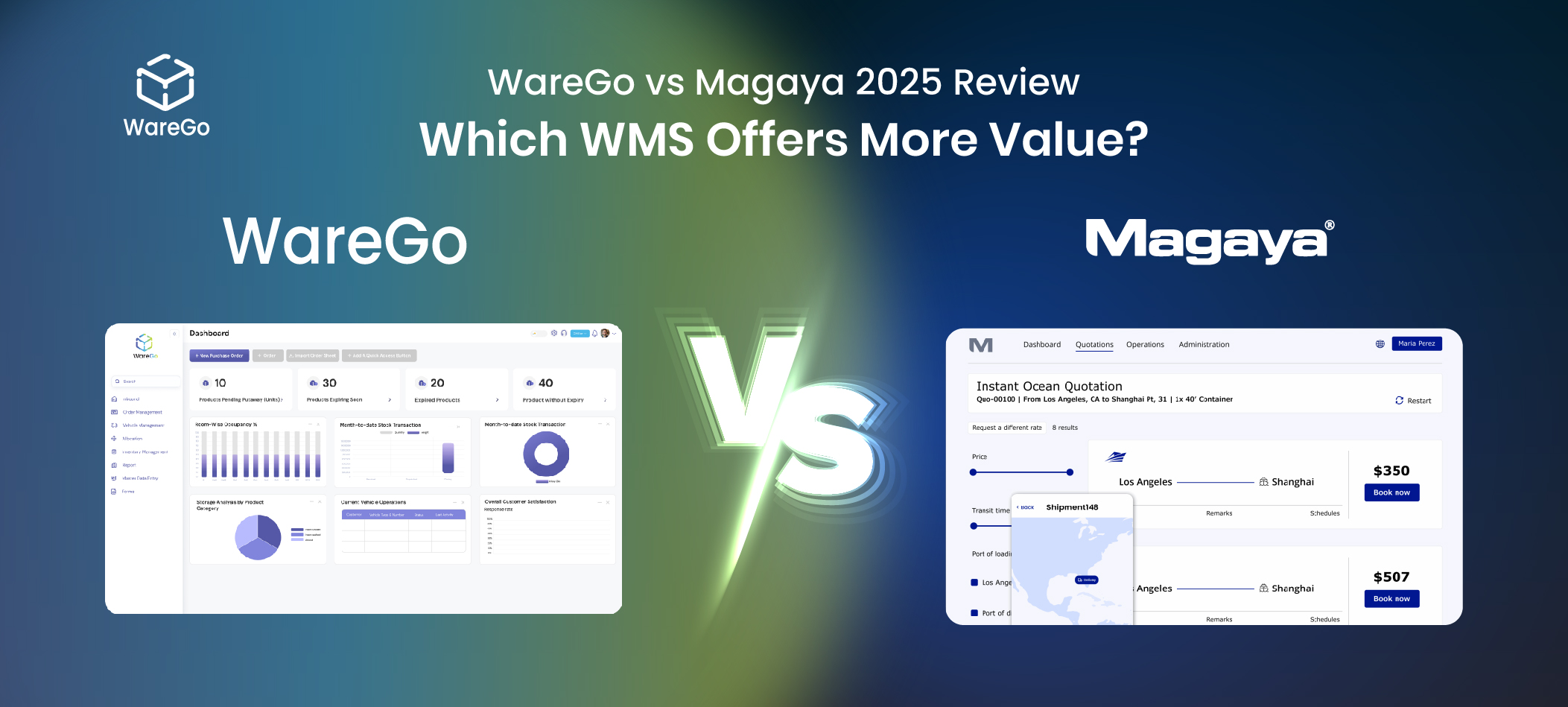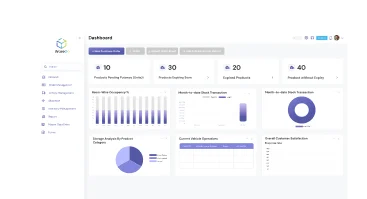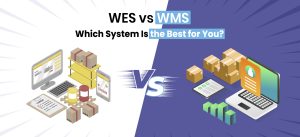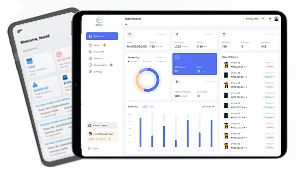
We’ve already reached the midpoint of 2025, and the way ecommerce, 3PL, manufacturing, and other businesses are scaling is eye-opening for business owners, creating a prominent space for warehouse management software that streamline processes and reduce operational errors.
According to a report published by Grand View Research, the global wms market size was calculated to be USD 2.88 billion in 2024 and is expected to grow at a compound annual growth rate of 19.9% between 2025 and 2030. This expansion is supported by businesses willing to automate tasks and achieve customer satisfaction.
When comparing WareGo vs Magaya, it is essential to note that these software solutions are well-established among users and perform effectively, depending on business needs and client preferences.
In this comparison article, we will break down all aspects, including features, price structures, integrations, user experience, and more, backed by real data and insights, to help our readers invest in a software that perfectly meets their needs in 2025.
Table of Contents
WareGo vs Magaya – Quick Comparison Table
| Features | WareGo | Magaya |
|---|---|---|
| Ease of Use | Minimalist interface that requires minimal training. | Complex interface with a steep learning curve. |
| Deployment Speed | Cloud setup, quick deployment, no implementation fee. | Lengthy onboarding and customization cycles. |
| Scalability | Scales easily for businesses of all sizes and grows with needs. | Good scalability but mostly suited for logistics firms. |
| Inventory Management | Real-time, convenient inventory tracking. | Advanced inventory controls for freight-centric environments. |
| Order Fulfillment | Streamlines fulfillment for speed and accuracy. | Reliable for freight and 3PL workflows. |
| Integrations | Integrates with almost all systems. | Limited eCommerce integrations; stronger in ERP, customs, freight. |
| Customer Support | 24/7 chat support with timely responses. | Limited customer support hours. |
| Pricing Transparency | Affordable and clear pricing published on website. | Pricing not clearly mentioned on website. |
| Mobile Accessibility | Feature-rich mobile app available. | Mobile app available but with fewer features. |
| Ideal Use Cases | 3PL, Food & Beverages, Cold Storage, eCommerce, Retail, Wholesale, Restaurants. | Freight forwarders, cus |
A complex setup and hidden charges may slow down your growth. Save your business with WareGo, a WMS built for fast-moving teams, offering simple onboarding, real-time visibility, and other features all included in a single, priced package.
Start a Free DemoCompany Backgrounds. FT. WareGo & Magaya
1. WareGo
WareGo, established in 2004, is a WMS software application that has been streamlining businesses since its inception, even in its early days as a startup. It has now become a trusted name for clients worldwide. The WareGo team utilized the latest technology and smart solutions to develop a tool that manages the inventory of high-functioning businesses, thereby improving their overall operational efficiency. Built not only to meet but exceed customers’ expectations, this WMS adapts to new industry trends and offers 24/7 customer support. At WareGo, the WMS software and team work hand in hand to help businesses succeed with excellence and precision.
- Serves all industries
- Offers 3 different packages to meet diverse needs
- Has 24/7 customer service support
- No implementation fee
- Cloud-based nature & mobile app offer connection on the go
- Have an array of features including B2B payments, reporting, and insights
- Provide a 1-month free trial with no credit card required
- Solutions include 3PL warehouse management system, inventory management software, and order management software
2. Magaya
Focused on logistics and supply chain automation, Magaya was founded in 2001 by three cofounders. Initially, the WMS software was designed specifically for freight forwarding startups, as it was built with their needs in mind. The customers and users Magaya attracted in its early days are pillars of its success today, as they provided the owners with honest opinions and reviews that helped drive improvement. Throughout the years, Magaya has evolved with the ever-changing logistics industry. The software, which initially started as an operations software for freight forwarding businesses, has evolved into a comprehensive solution that now includes features for warehouse management, cargo, e-commerce, logistics, and other exporting businesses.
- Focus on industries like freight forwarding, 3PL, NVOCC, warehouse, courier, customs brokerage
- Magaya offers multiple help resources
- The company works on a modular setup
- Magaya Connects offers an interconnected experience and different integrations
- The company is focused on customer loyalty
Comparison of Core Features
Choosing between 2 reviewed and ranked wms can be convenient if you know how you manage the everyday operational needs of your business.
While a general perspective is to choose a WMS software that offers more features, it is not always the most effective approach. The right approach is to work with a WMS that streamlines your operations, making them smooth, efficient, and reliable for your customer base.
Below, we delve into the details of how WareGo and Magaya perform where it truly matters for business owners seeking solutions to automate their tasks.
1. Inventory Management
| WareGo | Magaya |
|---|---|
| Built for modern, fast-moving businesses. | Built for complex supply chains and multi-location needs. |
| Simple, user-friendly, and quick to set up. | Requires more time and IT support for setup. |
| Efficient and straightforward with core functions. | Advanced and highly configurable with detailed controls. |
| Real-time tracking and automation prevent manual errors. | Advanced features manage regulated goods and compliance. |
| Real-time stock tracking, barcode scanning, automated updates. | Batch/lot control, serial tracking, custom statuses, segmentation. |
| Best for teams seeking reliability with minimal complexity. | Best for businesses handling large volumes and strict custody requirements. |
| Flexible and easy for growing businesses. | Powerful but more complex to manage effectively. |
2. Order Fulfillment
| WareGo | Magaya |
|---|---|
| Makes order fulfillment easier, smoother, and efficient for all teams. | Designed for freight forwarding, 3PL, and international logistics companies. |
| Supports pick-pack-ship workflow with fewer errors and faster turnaround. | Customizable workflows with detailed task assignments and staging options. |
| Barcode scanning and packing validation ensure accurate deliveries. | Groups and organizes orders based on routes, destinations, and transport type. |
| Batch and wave picking enable processing multiple orders together efficiently. | Automates shipping documents like customs declarations, invoices, and bills of lading. |
| Integrates with major shipping companies for labels, tracking, and real-time updates. | Suitable for compliance-heavy and cross-border shipping operations. |
| Cloud-based solution ideal for businesses seeking simplicity without heavy setup. | Requires onboarding, technical expertise, and training to be fully functional. |
| Best for small to mid-sized businesses aiming to simplify fulfillment. | Best suited for large logistics providers like Amazon. |
3. Real-Time Tracking
| WareGo | Magaya |
|---|---|
| Provides real-time tracking across all warehouse stages. | Offers real-time tracking within a full logistics ecosystem. |
| Gives instant visibility into stock levels, orders, and fulfillment status. | Tracks cargo movement, warehouse activity, inventory changes, and customs processes. |
| Automatic updates on receiving, picking, packing, and shipping. | Delivers detailed updates required for cross-border and 3PL operations. |
| Helps managers make quick decisions and customers track order locations. | Clients and their customers access statuses via mobile and desktop portals. |
| Keeps inventory synced across single or multiple warehouse locations. | Suited for freight forwarders and logistics providers needing high-level tracking. |
| No external tools or expertise required for accurate tracking. | Extensive tracking may be overwhelming for businesses with simple needs. |
4. Automation & AI Capabilities
| WareGo | Magaya |
|---|---|
| Uses automation to simplify daily warehouse tasks. | Automation built mainly for large logistics and freight operations. |
| Includes stock updates, order routing, low-stock alerts, and rule-based flows. | Focuses on freight forwarding, customs, and global shipping workflows. |
| Reduces manual input and speeds up accurate decision-making. | Setup requires expertise in configuration and workflow design. |
| Handles repetitive tasks like picklists, inventory syncing, and urgent orders. | Automation is powerful but complex for typical warehouse teams. |
| User-friendly system with no heavy training required for staff. | Better suited for enterprises managing international logistics operations. |
| Ideal for businesses seeking simple and efficient AI-driven automation. | Excessive for average businesses that need straightforward automation. |
5. Customization & Flexibility
| WareGo | Magaya |
|---|---|
| Flexible and straightforward WMS setup with minimal effort. | Complex setup process requiring technical expertise. |
| Cloud-based system managed by technical managers for clients. | Requires IT staff or consultants for deployment and configuration. |
| Customizes workflows, roles, and rules directly from dashboard. | Customization requires deeper system knowledge and configuration. |
| Scales easily from single to multiple warehouse locations. | Best suited for large enterprises with multi-location operations. |
| Reduces costs by removing need for developers or technical staff. | Higher implementation and training costs due to complexity. |
| Ideal for small and mid-sized businesses seeking simplicity. | Ideal for logistics-heavy businesses needing advanced control. |
Modern inventory management has no space for spreadsheets or siloed systems. With WareGo, automate your stock updates, order flows, and reporting with one single yet intuitive dashboard.
Try WareGo NowThird-Party Integrations
When comparing two of the best WMS software options on the market, understanding how well they integrate with other tools your business uses is extremely important. A system that offers seamless integration saves time and manual labor, reduces errors, and ensures smooth operations. This section is about the approach WareGo and Magaya take regarding third-party integrations.
1. WareGo
When it comes to WareGo, it offers comprehensive integrations to ensure your warehouse offers a completely connected and seamless experience. The following are the categorized integrations WareGo has to offer:
| eCommerce Platforms & Marketplaces | BigCommerce, Magento 2, MyStoreNo, WooCommerce, Shopify |
|---|---|
| ERP & CRM Systems | Oracle, SAP, Microsoft Dynamics, Hubspot, Odoo, Salesforce |
| Marketplaces | Amazon, Ebay, Etsy, Google Shopping, Walmart, TikTok Shop |
| Integrated Shipping Carriers | 99Minutos (eShip), APC, Asendia, Australia Post, Bring, Canada Post |
| Returns Management Platforms | Loop Returns |
| Integration Partners | APIWorx, ConstaCloud, Pipe17 |
| Other Integrations | 6 River Systems, Alloy Automation, Brightpearl, Channel Advisor, FlavorCloud, Flxpoint |
2. Magaya
Since Magaya WMS is a part of the broader Magaya Digital Freight Platform, it offers integrations that are largely associated with its own products or tools. Therefore, if you are already using the Magaya Digital Freight Platform, you can enjoy brilliant integrations; however, if not, you may encounter some limitations.
| Shipping & Logistics | Deliverr, DHL, Extensiv, Flexport, Narvar |
|---|---|
| Accounting and Payment Processing | Adyen, Braintree, Klarna, PayPal |
| Custom Compliance & Government | Australia, Canada, Mexico, New Zealand, UK |
| Analytics | Adobe Analytics, DataRobot, Elasticsearch, Google Analytics, KissMetrics |
| eCommerce | Adobe Commerce, BigCommerce, Salesforce Commerce Cloud, Shopify, WooCommerce |
| Business Applications | HubSpot, Microsoft Dynamics 365, Oracle NetSuite, Oracle, Sage |
| Cloud Storage & Data Management | AWS S3, Azure Blob Storage, Azure CosmosDB, Azure Data Lake, Azure EventHubs |
| Collaboration & Communication Tools | Hootsuite, Microsoft Teams, Notion, Slack, Zoho Cliq |
Both WareGo and Magaya offer excellent integrations, but WareGo clearly stands out due to the simplicity, speed, and relevance of the integrations it provides for modern warehouse operations.
WareGo has built-in support for all the popular and widely used ecommerce, shipping, and accounting tools. Another top feature is the convenient API access for custom connections offered by WareGo, as this software solution focuses on connecting everything with no technical expertise required.
Magaya’s integration options are also brilliant, but they are primarily tailored for freight forwarding businesses and have a steep learning curve, which makes training and technical expertise essential.
All in all, if a business is looking for integrations that are smooth, reliable, and require minimal technical setup, WareGo proves to be a more practical and overall efficient choice.
Pricing & Value
| Features (Included) | WareGo | Magaya |
|---|---|---|
| Cloud-Based Deployment | ✔️ | ✔️ |
| Minimal IT Involvement | ✔️ | 🔸 |
| Easy Workflow Customization | ✔️ | 🔸 |
| Scalability for Multiple Warehouses | ✔️ | 🔸 |
| Reduced Implementation Costs | ✔️ | 🔸 |
| Enterprise-Grade Features | ✔️ | ✔️ |
| No Developers Required | ✔️ | 🔸 |
Pricing is a crucial component when it comes to a wms. The complete cost that you pay to take the software onboard is not just the subscription price tag. It also includes features such as hidden costs and the scalability of the WMS in case your business grows in the near future. Below, you will find a detailed breakdown of how WareGo and Magaya handle pricing.
1. WareGo
Most vendors offer custom prices, hidden charges, and complicated price structures. WareGo takes a unique approach by listing a clear, tiered price structure, offering users clarity and transparency.
While vendors generally charge for everything, including onboarding, integrations, and even basic support, WareGo does not keep its customers guessing. It offers transparent pricing, no implementation fees, and no charges for add-ons. The best part? There are no long-term contracts to keep the clients bound for future services.
With WareGo, the pricing listed on the website is what you will pay; this means all features, including inventory tracking, automation, and core implementation, are included in the package, and none of them require additional charges.
The straightforward price model makes WareGo a preferred choice for businesses, as it helps them budget, knowing that no additional costs will occur at the end of the day.
| Plan | Price (per month) | Users | LPNs per Month | Facilities | SKUs | Key Features |
|---|---|---|---|---|---|---|
| Standard | $449 (Save 30%) | 25 | 5,000 | 3 | 1,000 | Basic inbound ops, limited reporting, limited returns, financing included, mobile app. |
| Pro | $779 (Save 50%) | 50 | 15,000 | 10 | 25,000 | Complete billing, 3 eCommerce integrations, limited advanced fulfillment, returns, APIs add-on, reporting add-ons. |
| Advanced | $1,149 (Save 30%) | 100 | 100,000 | Unlimited | Unlimited | Full automation, unlimited integrations, advanced fulfillment, fleet management, unlimited billing & support. |
2. Magaya
Unlike WareGo, which has a subscription-based pricing model, Magaya offers a modular model that results in a higher total cost of ownership. When you opt for their WMS software, you receive a basic wms with standard functions.
Still, if you seek advanced functions such as automation tools, e-commerce integrations, customized reports, or API/EDI access, you will need to pay an additional fee. Not just this, Magaya charges a separate fee for onboarding and staff training, making it a big investment on the client’s end.
Since Magaya does not disclose its price structure on its website, we gathered details from authentic third-party sites to inform our readers about their charges. The implementation fees can range from $1,000 to $10,000. This cost is not one-size-fits-all and depends on the complexity, the number of advanced modules added, and the type of support you seek.
For businesses seeking a fully functional WMS, one that requires no additional add-ons or pricing, Magaya’s WMS software can prove to be a complex and expensive option.
WareGo is designed to get your team up and running quickly. With no learning curve and zero hassle of setup, you can achieve measurable results in less time than a coffee break.
View PricingUser Experience & Interface
No matter how much we emphasize costing, the value and worth of a WMS is always determined by the usability and convenience it offers to the clients. Ease of use is essential, as it enables clients to quickly adapt to the software and carry out operations efficiently, thereby reducing errors that occur in warehouse management processes.
Let’s quickly shed some light on how WareGo and Magaya differentiate themselves in terms of user experience and interface design.
1. WareGo
WareGo was built with one idea in mind: to offer clarity and efficiency to warehouse owners in managing their day-to-day operations. Therefore, to make the vision come to life, the dashboard is designed to be clean, modern, and intuitive.
The layout is easy to use and allows new users to navigate through without requiring any extensive training. The WMS boasts several brilliant features that enhance convenience, including drag-and-drop workflows, smart search, mobile optimization, real-time alerts, and more.
This enables the software to perform swiftly across all mobile and desktop devices. The convenience is unmatched, regardless of whether you are looking for features like tracking inventory, fulfilling orders, or generating reports, as all options are conveniently placed within reach with just a few clicks.
The not-so-complicated learning curve makes WareGo a good choice for teams that are just starting out or need to get started with the software immediately.
2. Magaya
Magaya offers an extensive array of features; however, when it comes to the user interface, users often complain about outdated interfaces and the fact that this software is more geared towards logistics professionals who already have some experience with enterprise systems.
Additionally, the software can be overwhelming for new users or staff who are just beginning to use a WMS. The steep learning curve and complex technical layout make this system a poor fit for new and less experienced users.
While reviewing the feedback, we noticed that users required professionally supported training to adopt the software fully. While there is no doubt that Magaya is a powerful tool, it lacks ease of use.
It offers complexity, which is fine for freight forwarding companies and logistics operations, but not for teams who need a convenient, modern, and intuitive user interface.
Customer Support & Onboarding
The quality of customer support and the onboarding process are crucial when selecting a wms for your organization. When you find a reliable team behind a software solution, it makes a huge difference and enables your team to adjust to the system quickly. A customer support team and a convenient onboarding process mean your team remains confident even when issues arise.
1. WareGo
WareGo is developed to prioritize its customers above all else, and its customer support team is renowned for providing responsive and human-centered solutions. When you sign up on the website, you are assigned a dedicated customer support specialist who helps resolve your queries, customizes and sets up your workflows, and more, all without charging additional implementation or training fees.
The onboarding process is gradual, guided, and not at all rushed. It aims to get your team functional with the cloud-based in days instead of weeks. Customer support does not end once you are onboard; it continues through live chat support, email, and phone support.
Instead of using an automated knowledge base, WareGo has a human support team that addresses concerns and curates solutions that are genuinely beneficial. At WareGo, you receive a standard 30-minute timeframe to have your questions answered, and their proactive check-ins ensure your team is never left on its own.
2. Magaya
Like any other professional WMS, Magaya offers a proficient support team and a structured onboarding process; however, the twist is that all of this comes at an extra cost. Unlike WareGo, Magaya does not offer free implementation and charges around $1,000, which can increase to $10,000 depending on the complexity.
Also, the training sessions are billed separately, which adds to the cost. Magaya offers support and training through email and phone. Still, users often complain about the extended response times and a lengthy list of unnecessary steps required to connect with an agent.
If a business without a dedicated IT team is seeking a WMS solution, Magaya may not meet all the requirements for adoption and problem resolution, especially during critical times of need.
With WareGo, clients do not have to pay any extra $ for any standard features and functionalities. Whether it's implementation, training, or ongoing support, everything is included in one package. That is how we help businesses scale by charging transparent charges while saying no to hidden costs.
Talk to Our TeamReviews & User Feedback
Feature lists and sales pitches are a great way to persuade potential clients, but if you really want to make an informed decision for your wms, let user reviews be your guide. These reviews provide honest insights into the WMS software, including its potential advantages and disadvantages. Below is a brief overview of what customers have written online about the capabilities of WareGo and Magaya.
1. WareGo
When we evaluated the online reviews customers left for WareGo, we clearly see that this WMS earns a lot of good for its intuitive interface, convenient and quick onboarding process, and timely and responsive support.
Some customers reported that training new staff on this software was easy, the customization options are great, and help is readily available whenever needed. The software’s automation features and flexible structure are often cited as time-saving and not overly complex.
The platforms like G2 and Capterra hold 4.7+ star ratings, mentioning that the software is easy to use and offers top-notch customer satisfaction.
“We switched from a larger WMS vendor to WareGo and haven’t looked back. Everything just works, and their support team actually listens.” – Verified User Review.
2. Magaya
Magaya has secured a good number of reviews for its functionality, which is especially for the freight and logistics industry. Nonetheless, most user reviews have one thing in common is a steep learning curve and a constant need for training and support. Additionally, some clients complain that the UI is outdated, and others express concern about the separate costs for setup, maintenance, and training. Other reviews mention difficulties in navigating the system, an urgent need for formal instructions, and somewhat slower support response times.
“Customer service is non-existent! The monthly bill is always on time, but implementation is a very lengthy process with multiple charges and fees. If you try to find someone to answer your phone call after 3:00 PM on Friday, you are truly a lucky man! Support and customer service are not in their vocabulary yet.” – George G, Review on Capterra”
Pros & Cons Summary
After analyzing features, pricing, support, and customer reviews in detail, we are ready to provide a concise overview of the pros and cons to help our customers make an informed yet empowered decision for their warehouse management needs.
1. WareGo
Pros | Cons |
| Transparent pricing that includes all features in a single price tag. No implementation cost or maintenance and support fees are required. | It has a vast array of features and functionalities that might be unnecessary for small businesses or single-location warehouses. |
| The interface is modern and intuitive, and offers a short learning curve. | While rapidly growing and innovating, WareGo is relatively new and less expensive compared to other WMS giants in the market. |
| The onboarding process is completed in a matter of days, and live support is included. | |
| For effective inventory control, the software features built-in automation and AI tools. | |
| A wide range of integration options is available with e-commerce platforms, ERP systems, CRM systems, and shipping tools. | |
| In terms of usability and reliability, WareGo has received brilliant online and in-person feedback. |
2. Magaya
Pros | Cons |
| Magaya is a leading WMS in terms of comprehensive logistics functionalities and freight forwarding tools. | The pricing is unclear and not mentioned on the website. Additionally, most features and functionalities are sold as separate add-ons with their own price tags. |
| It supports multi-location warehouses and complex work environments. | There is a separate fee for onboarding and training the warehouse staff. |
| The flexibility offered by the tool is brilliant, and industry-specific modules further enhance its value. | Due to dated UI and dense workflows, the software has a steep learning curve. |
| The support responsiveness does not receive much positivity, according to former clients. | |
| Not a cup of tea for businesses that are seeking ease of use and convenient adaptation. |
Best For Whom?
Ultimately, when choosing between WareGo and Magaya, the key factors to consider are the model, growth plans, and the level of complexity you are willing to manage in your WMS software. Below, we have listed which of these software programs is best suited for each:
1. WareGo
WareGo works perfectly for most businesses, including ecommerce brands, 3PLs, DTC retailers, and growing small to medium-sized businesses that seek speed, efficiency, simplicity, and scalability. This WMS software is the best WMS if they want:
- A wms that is good to go without requiring any extensive setup.
- Affordable, clear, and one-time pricing to avoid breaking the budget.
- Built-in features for automation and real-time visibility.
- A platform that offers scalability and grows with the business without needing add-ons of technical support from the company.
WareGo is ideal for clients running single warehouses or managing distributed inventory throughout multiple locations. The software is designed to minimize manual input in warehousing, reduce errors, and maintain smooth operations.
2. Magaya
It is more suitable for freight forwarding businesses, customs brokers, and enterprise-level logistics companies that manage complex workflows on a day-to-day basis and have highly specific needs when it comes to warehousing. Magaya is a great option for teams that:
- Operate in freight-heavy or global logistics environments.
- Need a multi-layered compliance and documentation workflow.
- Have an IT-trained team onboard that handles everything from configuration to ongoing adjustments and more.
- Have an extensive budget for a wms and can afford to pay for separate add-ons, functionalities, trainings, and more.
Magaya is a great option for a business that is fine with extensive setup, complex interface, and typical freight control and logistics handling features. However, if this is not what your business is looking for, this wms will be of no use to you.
Final Verdict: WareGo vs Magaya – Which One Should You Choose?
WareGo and Magaya both hold their separate positions in the industry and are capable of offering unique solutions that cater to different needs. Both platforms have different philosophies that they are built upon, and may be more suitable for different industries when it comes to being selected for warehousing operations.
As is widely known, Magaya is a great option for freight forwarding companies, enterprise logistics, and customs brokers that have complex needs and working conditions. With deeply specialized workflows, an extensive onboarding process, customization options, and support, this WMS software is ideal for businesses with a substantial budget for warehousing automation. If you belong to such a company, Magaya is a perfect fit for your needs.
However, if you belong to an e-commerce brand, a third-party logistics company, or a business that is just starting out and in its growth phase, WareGo is a smarter choice in terms of agility, transparency, and speed.
While being a cloud-based WMS that is affordable, it excels at delivering enterprise-grade features, including, but not limited to, real-time tracking, automation, and smart inventory tools. In comparison to other options on the market, WareGo offers approachable, scalable, and pocket-friendly packages.
With WareGo, you get no hidden charges, no implementation charges, and no complexity. Just a wms that manages operations, adds efficiency to processes, and grows as your business grows. Contact WareGo now.
WareGo is affordable and is built to grow! With automation, flexibility, and integrations, this software scale as your business grow. No more switching systems when a business expands.
View PricingConclusion:
WareGo and Magaya are excellent wms, each with its own unique set of strengths and weaknesses, catering to your specific business needs.
Nonetheless, the choice of the best WMS depends solely on what matters most to your business operations. Evaluate if you are more inclined towards logistics features or ease of use, transparent price structures, and flexibility.
By reading our guide, you can learn about both platforms and determine whether they align with your business goals. We hope our input enables you to make informed decisions that support your long-term growth and provide you with ultimate operational efficiency.
FAQs
What is the main difference between WareGo and Magaya?
WareGo is a suitable WMS for companies that require scalable features, process automation, and support without expensive pricing models and extensive deployment times. WareGo is designed to scale alongside businesses as they grow, all while seamlessly managing your operations.
Does WareGo charge extra for onboarding and support?
No, WareGo does not charge extra for onboarding and support. With WareGo, customers receive all-inclusive pricing, so they don’t need to worry about hidden charges along the way. All features and functionalities are included in the subscription package, ensuring you get started with your operations right away.
Does Magaya publicly list its pricing?
No, Magaya does not display its pricing on its website, and clients must opt for a consultation to receive a quote. Additionally, Magaya charges separately for setup, training, and advanced modules.
Which wms is better for growing businesses?
For growing businesses, WareGo excels in terms of scalable features, automation, and the support it provides. The perk that helps clients the most is their affordable pricing and shorter deployment times, which enable businesses to get up and running quickly.




